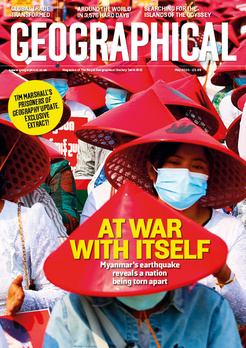Passport

Documentary photographer Sean Sutton tells Bryony Cottam what he has learned from 30 years on the road

 Sean’s travel insights
Sean’s travel insights
• Be inquisitive; the world is more complex and fascinating than we often realise
• Approach other people and cultures with humility and an open mind
• Pay attention to the mores of locals and the way they behave
Travel, says Sean Sutton, can help you find your purpose in life. Although, he adds, that very much depends on you. ‘There are lots of ways of travelling. You could go to Thailand and spend the whole time on the beach, maybe try some Thai food. But if you’re inquisitive, if you realise that the world is a lot bigger than what you see around you, it can be revelatory.’
For Sutton, it was travelling through Southeast Asia in 1988 that inspired his 30-year career as a documentary photographer. He’d been taking ‘pretty pictures’, as he calls them, of the countries’ vibrant culture and traditions. ‘In hindsight, I could sense that I was struggling to understand the point of what I was doing,’ he says. ‘It just didn’t seem meaningful.’
When he stumbled across a situation on the Thailand–Burma border (a wave of protests and riots had been sweeping across Burma, reaching a peak that August in what’s now known as the 8888 Uprising), he realised he had an opportunity to make a difference. ‘It was a moment where everything sort of came together.’
Sutton would go on to spend two years working in the jungle with Burmese refugees and resistance groups. ‘That was my foundation course in photojournalism,’ he says.
Since then, his work has taken him to more than 40 countries, where he has focused on amplifying marginalised voices, particularly in areas of conflict and humanitarian crisis, often working directly with aid organisations. ‘Photography is a really powerful tool for telling stories,’ he says. ‘Collaborating with NGOs and using images to tell the story of crises and injustices is one of the most effective ways to support the organisations working on the ground.’
Sutton maintains that, even today, documentary photography can reveal the truth of a moment in time. ‘It’s all about how honest you are as a photographer,’ he says. ‘I’ve certainly seen scenes that have been orchestrated, and that’s fine, as long as it’s been disclosed. Photographers who are not honest really do a disservice to all of us who are out there trying to show the truth.’
To the experienced eye, it can be easy to spot a manipulated image, but sometimes it can be difficult to know what to believe when different media are sharing different views, and some issues never make the news at all. But Sutton thinks that travel can help us to fill in the gaps in our knowledge and better understand the wider world.
‘Take Laos,’ he says. Between 1967 and 1973, the USA dropped 260 million bombs on Laos – a covert mission that the US government tried to keep secret for years – making it the most heavily bombed country in history. ‘A lot of people travel to Laos,’ says Sutton, ‘and they inevitably find out about its recent history and are quite horrified by it. Many often feel mobilised to do something to help the organisations that are trying to solve the ongoing problems there.’
Sutton cautions that while tourism can benefit regions that have been affected by disasters and conflict, especially if communities have been reliant on tourists for income, visitors should think carefully about why they want to visit. There’s a lot that a traveller might not know about a new country they visit, even if they do their research before they go.
For that reason, Sutton says it’s important to pay attention while you’re there. ‘It’s not just about written rules and often it’s not about religion – it’s about how people feel, their culture and their way of living. In a lot of places, people are very tolerant, even when tourists are behaving very badly, so you need to be sensitive to how they – and you – behave, partially because people are likely to be more accepting and that can make the whole experience more rewarding.’




